お知らせ
東日本大震災後の我が国合板産業の取組みについて
日合連では、東日本大震災後の復旧・復興等の取みを「東日本大震災後の我が国合板産業の取組みについて」(和文、英文)として以下のとおり取りまとめました。
この文書は、本年10月開催された第33回日・台・韓合板業者懇談会や日本、マレーシア、インドネシアの三国合板合同会議等の内外の会議や講習会で報告されています。
【東日本大震災後の我が国合板産業の取組みについて】
1.東北地方太平洋沖地震の発生と合板産業の被災状況
2011年3月11日に発生した東北地方太平洋沖地震により、宮城県石巻市、岩手県宮古市、同大船渡市に所在する日本合板工業組合連合会(日合連)の6組合員企業が甚大な被害を受けた。被災企業の合板生産量は、全国の合板生産量の約3割で、合板供給量の6割を占める輸入合板を含めると我が国の合板供給総量の約12%の供給が困難となった。
2.仮設住宅等の復旧活動と合板への仮需拡大への対応について
津波等による大量の住宅の倒壊、流出等により、仮設住宅を約5万2千棟建設することとなった。また、東北地方の合板メーカーが被災し合板供給量が大きく減少するとの見方から全国の流通業者や工務店等において構造用合板の不足感が生じ、当面の手持ち在庫の確保のため通常の何倍もの発注を行ったため仮需が発生したと見られる。
合板工場の被災による生産減、仮需等による全国の工務店等の資材不足に対応するため、3月23日に日合連で「緊急会合」を開催し、被災していない国内合板メーカーが、それまでの減産からフル生産を行い、復旧・復興に不可欠な国産合板を安定的に供給することを確認し日合連会長声明として公表した。この結果、4月以降生産量が漸次回復し6月には日合連推計で総生産量は約20万m3と、ほぼ前年並みの生産レベルとなった。
3.合板輸入の急増と非JAS、偽装JAS合板への対応等について
合板の不足感から、これまで全く合板を扱ってこなかった異業種や流通業者等が3月下旬から4月にかけて中国やマレーシアなどに大量発注を行った。このため5月、6月の合板輸入量は、対前年比で63%、38%増加した。
これら輸入合板の中には、JAS規格合板(F☆☆☆☆)でないものが相当量含まれていると言われ、仮設住宅や一般住宅等で使用されるとシックハウス症候群を発症することが危惧されている。さらに、偽装されたJAS認定工場証明書や偽装JASマークを付したサンプル合板が確認されている。このため政府は全国の関係団体等に注意喚起を行っている。日合連としても、JAS合板を利用するように全国のハウスメーカー、工務店に対して要望をおこなった。
4.被災企業の復旧・復興状況等について(平成23年9月24日現在)
被災企業においては、従業員の安否の確認、救援物資の配布を第一義として復旧活動を行い、その後順次工場内の建物の修復、瓦礫処理、流木丸太の回収、保管在庫の確認・販売再開等を実施し、さらに合板製造ライン等の本格的な復旧作業を行っている。
セイホク(株)は、7月上旬に生産ラインを復旧し、同月下旬に針葉樹構造用合板の出荷を再開した。西北プライウッド(株)は8月下旬に試運転を行い9月下旬に出荷を再開した。石巻合板工業(株)は、8月中旬から生産ラインの試運転を行い9月上旬には出荷を再開し、9月中には、被災前の生産可能量の半分を回復した。ホクヨープライウッド(株)は、7月に生産ラインを復旧し8月上旬に出荷を再開した。
5.今後の復興に向けて
我が国合板産業は、森林整備の推進、地域経済の再生等のため、国際競争力の確保・強化を基本としつつ、総合的な合板産業の発展を目指している。このため、合板やLVL製造ラインの本格的復興はもとより、木質瓦礫や地域材の活用によるパーティクルボード等の生産施設やカスケード利用に基づく熱供給や発電施設の整備を行うこととしている。また、これら施設を活用して住宅や公共建築物等への国産のJAS規格合板の使用、木質バイオマスのマテリアル及びエネルギー利用等を積極的に推進していくこととしている。
東日本大震災による被災と復旧状況
【岩手県宮古市】
【災害時】
【復旧後】
単板工場建屋
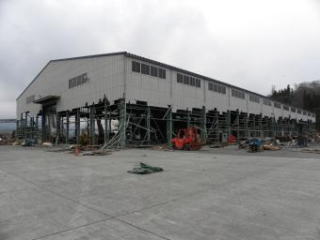 |
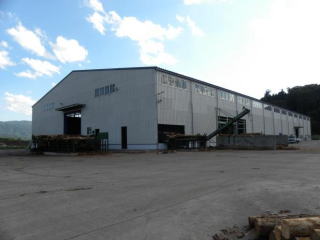 |
単板工場建屋
 |
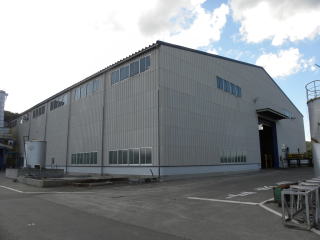 |
ロータリーレース
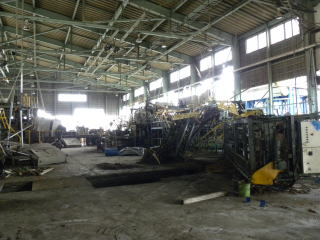 |
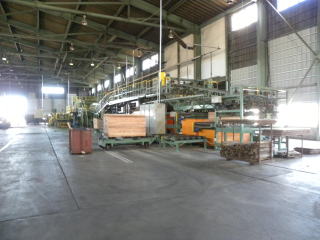 |
合板工場事務所
 |
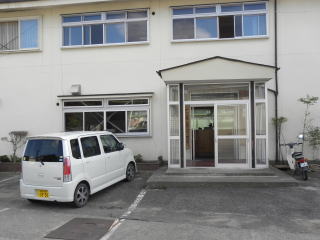 |
合板工場建屋
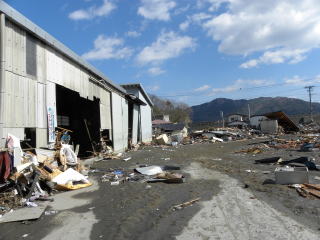 |
 |
【宮城県石巻市】
(A企業)
【災害時】
【復旧後】
工場全景
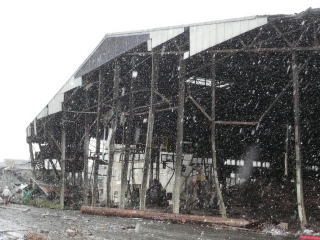 |
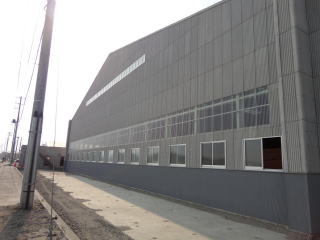 |
ロータリーレース
 |
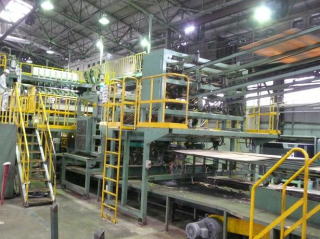 |
ロータリーレース周辺
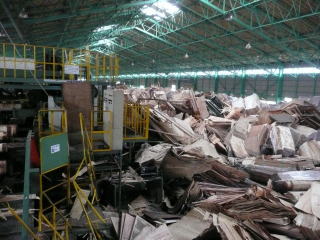 |
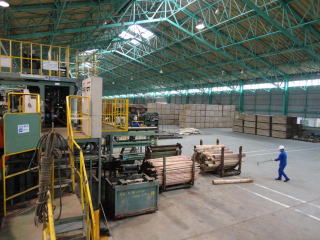 |
ドライヤー
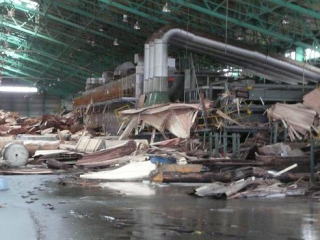 |
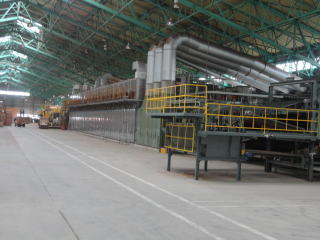 |
スプレッター
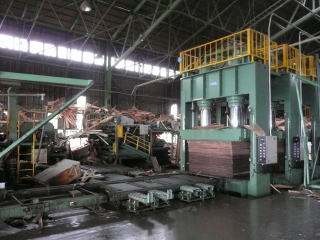 |
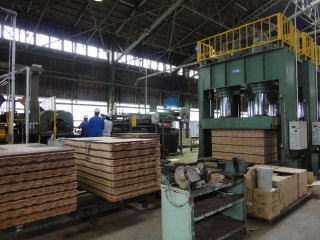 |
合板仕上げライン周辺
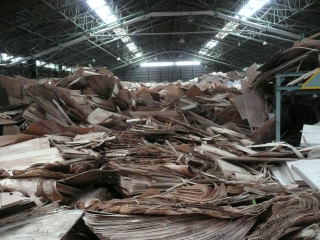 |
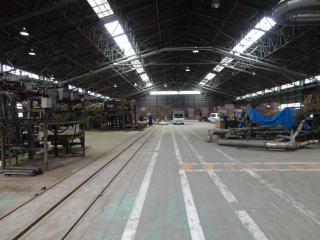 |
回収・はい積みされた流出丸太 被災しなかった在庫製品(再検査後)
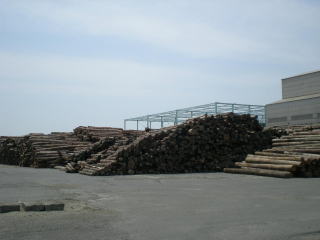 |
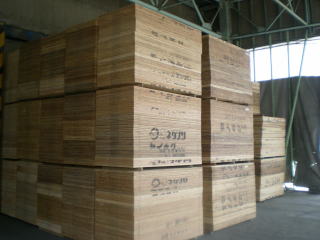 |
(B企業)
【災害時】 【復旧後】
合板工場建屋
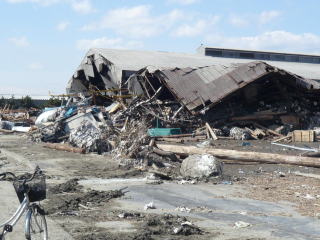 |
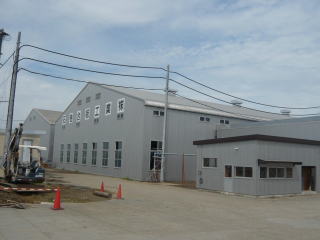 |
ロータリーレース
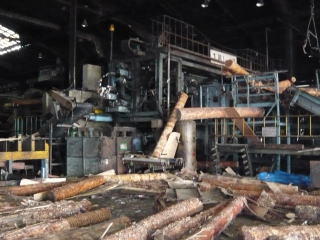 |
 |
ドライヤー
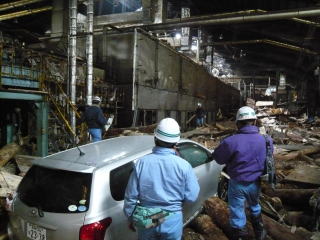 |
 |
コールドプレス
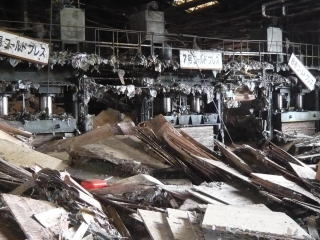 |
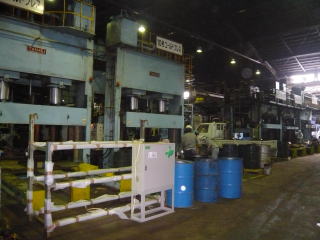 |
ホットプレス
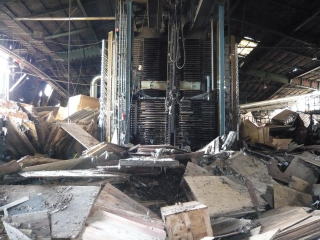 |
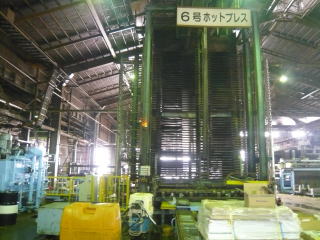 |
検査出荷場
 |
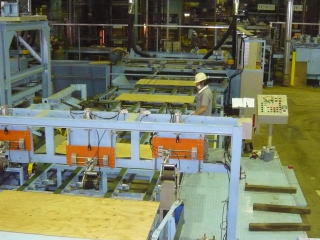 |
【その他】
倒れる鉄塔 破壊された護岸
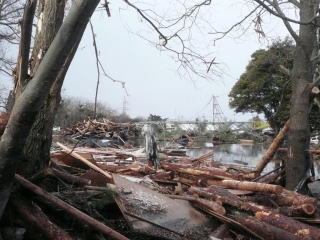 |
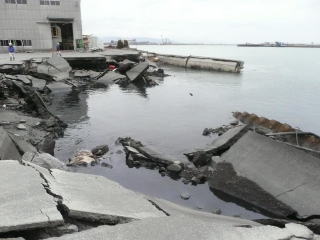 |
工場内に流入した車 流出した原木
 |
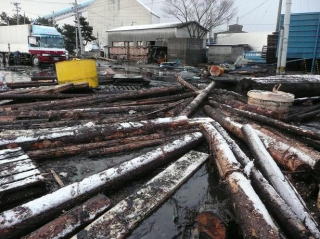 |
Actions by the Japanese Plywood Industry in
the
Aftermath
of the Great East Japan Earthquake
Japan
Plywood Manufacturers’ Association
1.
The occurrence of Tohoku Region Pacific Coast
Earthquake and the conditions of damage of the plywood industry in Japan
Six member corporations of Japan Plywood Manufacturers’
Association (JPMA) located in Ishinomaki City, Miyagi Prefecture, Miyako City
and Ofunato City in Iwate prefecture suffered from severe damage by Tohoku
Region Pacific Coast Earthquake of March 11, 2011.
The plywood production volume of these disaster-stricken
companies accounts for about 30% of the domestic plywood production volume and
the interruption of plywood supply occurred for about 12% of Japan’s total
plywood supply where 60% is import.
2.
Restoration activities such as the
construction of temporary houses and the response to anticipatory or
speculative demand increases.
About 52,000 units of temporary housing were decided for
construction because of the massive damage of houses, such as collapse and
washout, caused by the tsunami.
Furthermore, since the plywood manufacturers in the
Tohoku region were hit by the disaster, anticipation of a sharp fall of plywood
supply arose, which triggered perceptions of shortage of structural plywood
among distributors and contractors throughout the country.
Accordingly they placed orders for plywood in quantities
which were many times greater than normal in order to get enough materials on
hand for the moment. This is likely to have created anticipatory or speculative
demand.
In order to cope with the shortage of materials for
nationwide contractors and others due to the decline of production at the
damaged plywood plants and the anticipatory or speculative demand, JPMA convened an “Emergency Meeting“ on
March 23 and confirmed that the domestic plywood manufacturers which escaped
the disaster were going to stop the reduced production which had been continued
until then and to start full capacity production and that they would stably
supply domestic plywood which is indispensable for restoration and
reconstruction.
This was announced as the Statement of the Chairman of
JPMA. As a result, production in and after April began to recover gradually and
the total production volume, as estimated by JPMA, returned to about 200,000m3
in June, approximately the same level as the last year.
3.
Surge of plywood import and actions against
non-JAS and false-JAS plywood
Because of
the perceived shortage of plywood, other businesses and distributors, who have
no prior experience of plywood business, placed
enormous quantities of order in China, Malaysia, etc from the end of
March to April.
As a
result, the plywood import in May and June increased 63% and 38% respectively
from the same month of the last year. Such imported plywood is said to include
a considerable volume of plywood which does not meet JAS, the Japanese
Agricultural Standards(F☆☆☆☆).
There are
even concerns that if such plywood is used for the construction of temporary
houses and ordinary houses, it can cause sick house syndrome. There are sample
plywood pieces spotted which have a falsified JAS plant certificate or a fake
JAS mark.
The
government of Japan, therefore, has issued warning to the organizations
concerned. JPMA has requested homebuilders and contractors across the nation to
use JAS-compliant plywood.
4.
The state of restoration and reconstruction
of the disaster-stricken companies (as of September 24, 2011)
The disaster-stricken companies started their restoration
activities, giving the highest priority to the confirmation of their employees’
safety and the distribution of relief supplies. Successively, they carried out
the repair of plant buildings, the removal of rubbles, the recovery of drifting
logs, the confirmation of stored inventories, the resumption of sale, etc.
Further, they began all–out restoration work of their
plywood production lines.
Seihoku Corporation restored their production lines in
early July and resumed shipment of softwood structural plywood in the end of
July.
Seihoku Plywood Corporation made test runs of the
repaired production lines in the end of August and restarted shipment in the
end of September.
Ishinomaki Plywood Manufacturing ran tests of the
repaired production lines in and after mid-August, restarted shipment in early
September and will have restored a half of their pre-disaster production
capacity by the end of September.
Hokuyo Plywood restored their production lines in July,
and reopened shipment in early August.
5.
Toward the reconstruction in the future
The Japanese plywood industry aims to develop into a
comprehensive plywood industry in order to promote forestation activities and
to revive regional economy, based on the need to gain and strengthen
international competitiveness.
To this end we are working hard for the complete
rebuilding of plywood and LVL production lines as well as for the establishment
of the facilities to produce particle boards, etc, using wooden rubbles and
local wood and also for the development of plants to supply heat and generate
electric power through the cascade use of wood.
We will also actively carry forward the use of
JAS-compliant domestic plywood in houses, public buildings, etc, and the use of
wood biomass as material as well as for energy.
Damage by the Great East Japan Earthquake
And the State of Recovery
【Miyako City, Iwate Prefecture】
【At
the time of the Disaster】
【After
Recovery】
Veneer Plant Building
 |
 |
Veneer Plant Building
 |
 |
Rotary Lathe
 |
 |
Plywood Plant Office
 |
 |
Plywood Plant Building
 |
 |
【Ishinomaki City, Miyagi Prefecture】
(Company A)
【At
the time of the Disaster】
【After
Recovery】
Plywood
Plant Building
 |
 |
Rotary Lathe
 |
 |
The Surrounding of Rotary Lathe
 |
 |
Dryer
 |
 |
Spreader
 |
 |
The Surroundings of a Plywood Finish Line
 |
 |
Drifting logs gathered
Products in inventory which
were not affected
and accumulated ( after inspection )
 |
 |
(Company B)
【At
the time of the Disaster】
【After Recovery】
Plywood Plant Building
 |
 |
Rotary Lathe
 |
 |
Dryer
 |
 |
Cold-press
 |
 |
Hot-press
 |
 |
Inspection and Shipment Area
 |
 |
【Others】
toppled steel tower destroyed
seawall
 |
 |
Vehicles swept into a plant logs
flowing out
 |
 |